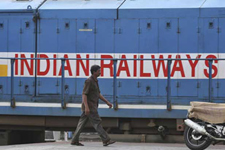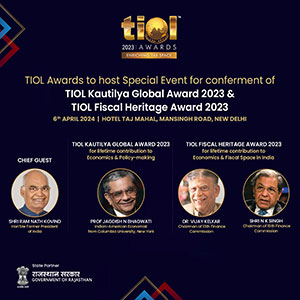TIOL - COB(WEB) - 197
JULY 22, 2010 By Shailendra Kumar, Editor THE GST-caravan took a long stride forward yesterday when the Centre, the major partner in the on-going multi-lateral talks, for the first time propounded the 'Theory of Fusion' for dual GST rates for the dual GST regime. In his address to the members of the Empowered Committee of State Finance Ministers, the Union Finance Minister, Mr Pranab Mukherjee, who has turned many 'political stones' in his favour in the recent weeks, rolled out the hitherto excessively-speculated range of GST rates for the proposed system. Mr Mukherjee admitted that although the full potential of the proposed system can be realised only if India goes for a single rate structure with the merger of the rates for goods and services but given the geopolitical fiscal and federal realities, the GST roll-out needs a phased approach for painless transition. He said that the Centre is agreeable to the dual rate structure for the goods, in the inception.
For April 1, 2011, he proposed 6% as the lower rate essentially for essential goods and 10% as standard rate for the large chunk of goods. For the Services, he advocated the mean rate of 8%. He also urged the States to adopt the same rates so that the final duty liability could range between 12-20%. Given the fact that all exemption notifications cannot be consigned to flames right in the beginning, the effective duty rate would be about 15%.
Not missing the sight of the 'Theory of Fusion', Mr Mukherjee further suggested that depending on the buoyancy index of revenue collections in the first year, the peak rate of 10% may be reduced to 9% in the second year, and 8% in the third year. Since the third year is proposed to see the actual event of fusion, the lower rate of 6% would jump to 8% to merge with the service tax rate of 8% and reduced rate of 8% for the goods.
Now the question is - What if there is no eye-pleasing buoyancy in the revenue collections in the first two years. Mr Mukherjee has committed himself to full compensation to all those States which may suffer bouts of fiscal spasms. In other words, the FM has worded his commitment in such a fashion that if need be, the Finance Commission's recommendations could be overlooked to provide more funds for compensation. In fact, to give a taste of the sweet-pill promised yesterday, the Finance Minister announced that the Centre has decided to clear the outstanding payments for revenue loss incurred on account of the CST reduction. He also indicated that the Centre has been waiting for the EC's formula to work out the payment for the current fiscal.
Notwithstanding the tall promises of the Union Finance Minister, the States' skepticism did not ebb much, and they insisted on retaining the CST by lending it a new name for at least first two years. This is certainly not a very good news for the industry and trade. In fact, what shows the aversion of the Centre to this proposal is the fact that Mr Mukherjee undiplomatically expressed his displeasure to the State leaders insisting on retaining the CST in some disguised form with a vague nomenclature.
Anyway, on the exemption threshold front, Mr Mukherjee made it clear that Rs 10 lakh should be the threshold for both the Centre and the States for both the goods and services. However, the EC highlighted the plight of the North-Eastern States which fear that such a high threshold would wipe off their entire taxbase. Therefore, their suggestion is that the threshold should be Rs 5 lakh. Now, the FM has take a call on this issue and work out a special compensation package for the seven sister-states. For the Compounding scheme, the threshold could be anything between Rs 50 lakh and Rs one crore for small business entities. The Centre also minced no words by making it clear that it would align its exemption notifications with the number of VAT exemptions retained by the States. There is no question of any mismatch in this respect.
Mr Mukherjee deservingly looked very pleased to announce that the State of Punjab has agreed to the proposal for the GST to subsume the Purchase Tax. There would be hundred percent compensation for the same but only for foodgrains. Since he has managed to thaw the ice in the case of Punjab, the other States levying purchase tax are also likely to join the bandwagon.
On the IT infrastructure front, Mr Nandan Nilekani's presentation was simply spell-binding. Those who were inside the closed-door presentation, confided in TIOL that Mr Nilekani's IT roadmap was lapped up by the States, and Mr Asim Dasgupta quickly accepted the Centre's proposal to set up an Empowered Group to take vital decisions to implement the same. Mr Nilekani basically proposed the system of COMMON PORTAL which would be known as 'GST Network' (GSTN). Who would own this? A special purpose vehicle (SPV) would be floated to own this portal. The three stake-holders would be the Centre, the States and the Technology partner. The Empowered Group would select one of the two National Information Units - the NSDL and the Payment Settlement Corporation for working on the project. This GSTN will provide dedicated interface to the taxpayers, the Centre and the States. While discussing and thrashing out major differences, the Centre has also handed over the final draft of Constitutional amendment to the EC. The EC is now scheduled to meet again on August 4, and would give its recommendations if it sees any need for further fine-tuning. Once it is done, the Centre is going to table it in the Parliament during the Monsoon Session itself. On the administrative front, the CBEC has been receiving inputs from various CCs' zones on the proposed structural changes in the shape and size of the field formations. Given the massive jump in the assessee-base to over 50 lakh, the CBEC is likely to go for at least 250 Commissionerates to handle the implementation. Since the focus is going to be on Audit, there would be at least 40-50 'Audit Commissionerate'. For anti-evasion, about 22 new Commissionerates would be required. And about 160 new GST Commissionerates would be in place as GST Commissionerates. For additional manpower, the cadre review is already on, and a quick detailed plan approved by the Centre would help the CBEC restructure its field formations on priority. If April 1, 2011 is the deadline, the draft law along with the GST procedures are required to be in place at least four months in advance. Even the Common Portal needs to be in place in advance. The only saving grace is that all these milestones have been identified so that hardship could be avoided for the taxpayers. By all standards, India now stands at a critical stage of transition into a much-reformed new indirect tax regime, but are our trade and industry ready for the same? Only the time will have an answer to this question! |









 Download PDF
Download PDF





